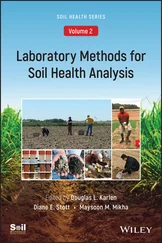Soil Health Analysis, Set
Здесь есть возможность читать онлайн «Soil Health Analysis, Set» — ознакомительный отрывок электронной книги совершенно бесплатно, а после прочтения отрывка купить полную версию. В некоторых случаях можно слушать аудио, скачать через торрент в формате fb2 и присутствует краткое содержание. Жанр: unrecognised, на английском языке. Описание произведения, (предисловие) а так же отзывы посетителей доступны на портале библиотеки ЛибКат.
- Название:Soil Health Analysis, Set
- Автор:
- Жанр:
- Год:неизвестен
- ISBN:нет данных
- Рейтинг книги:3 / 5. Голосов: 1
-
Избранное:Добавить в избранное
- Отзывы:
-
Ваша оценка:
- 60
- 1
- 2
- 3
- 4
- 5
Soil Health Analysis, Set: краткое содержание, описание и аннотация
Предлагаем к чтению аннотацию, описание, краткое содержание или предисловие (зависит от того, что написал сам автор книги «Soil Health Analysis, Set»). Если вы не нашли необходимую информацию о книге — напишите в комментариях, мы постараемся отыскать её.
Soil Health Analysis, Set — читать онлайн ознакомительный отрывок
Ниже представлен текст книги, разбитый по страницам. Система сохранения места последней прочитанной страницы, позволяет с удобством читать онлайн бесплатно книгу «Soil Health Analysis, Set», без необходимости каждый раз заново искать на чём Вы остановились. Поставьте закладку, и сможете в любой момент перейти на страницу, на которой закончили чтение.
Интервал:
Закладка:
From 1900 to 1970
Examples of influential publications include one by Yoder (1937), who concluded poor soil structure was a major factor limiting various soil functions because of its influence on processes including granulation (aggregation); wetting, drying, freezing and thawing cycles; organic matter accumulation and decomposition rates; biological activities, plant root development, as well as tillage and crop rotation response. This remains relevant because the work led to development of the “Yoder” water‐stable aggregate method that is currently being used for many soil health assessment projects. Another is Waksman and Starkey (1924) who measured CO 2emissions as an indicator of the “decomposing power of soils” – using procedures similar to those associated with the Haney test (Haney et al., 2006).
Wilson and Browning (1945) emphasized soil aggregation and documented significant differences for a corn ( Zea mays L.) – oat ( Avena sativa L.) ‐ meadow rotation versus continuous corn. They also reported that after only four years of continuous corn aggregation levels created by either alfalfa ( Medicago sativa L.) or bluegrass ( Poa pratensis L.) was decreased to levels below that found for the corn‐oat‐meadow rotation. Conversely, implementing the corn‐oat‐meadow rotation after 11 years of continuous corn increased aggregation. Another pioneer was Selma Waksman, who is more famous for the discovery of streptomycin, conducted early work on understanding the nature of soil organic matter (SOM), including the decomposition of plant components by soil microorganisms and preservation of nitrogen (N) in the SOM (Waksman and Hutchings, 1935). Waksman and colleagues also focused on the formation of soil aggregates during the microbial decomposition process (Martin and Waksman, 1939, 1941). In another review, Whiteside and Smith (1941) documented the importance of measuring SOM and total N, two factors important for soil health. They concluded that since the origin of agriculture per se soil productivity had gradually been depleted due to crop production. Similarly, Van Bavel and Schaller (1950) showed that both cropping systems and soil erosion influenced SOM content. They reported that 11 years of continuous alfalfa increased SOM, but 11 years of bluegrass did not. They also found that although a corn‐oat‐meadow rotation did not maintain SOM levels, although the decrease was “small and probably not significant.”
Post‐World War II soil management studies gradually began to focus more on soil physical and chemical manipulation than biology, primarily because equipment manufacturing and fertilizer development technologies advanced rapidly, while biological theories (e.g., discovery of deoxyribonucleic acid [DNA]), methods of analysis, and modern instrumentation took additional decades to evolve. The importance of soil biology was not overlooked, as confirmed by Lyon et al (1950) who concluded plowing and cultivation should be used to loosen the soil with a minimum of soil aggregate destruction. Similarly, Browning and Norton (1947) found that crop yield associated with moldboard plowing was generally better than yields associated with other forms of tillage. They attributed this response to the moldboard plow design, which was intended to accentuate granulation by lifting, twisting, and shearing the soil, while at the same time, inverting organic residues on or at the soil surface for subsequent decomposition. During this same era, advances in chemical weed control were also made, but the use of tillage was still favored despite writings such as “Plowman’s Folly” by Faulkner (1943).
Tillage and cropping system studies such as those by Van Doren and Klingebiel (1952) and Klingebiel and O’Neal (1952) provided data that would now be regarded as critical soil health information. They reported that under virgin conditions, surface soil structure in most Corn Belt loam and silt loam soils was granular or crumb‐like. The soils were also highly aggregated and generally had low bulk density. However, as tillage intensity increased and crop rotation diversity decreased, the granular soil structure deteriorated to a fine, fragmented or massive condition. Annual moldboard plowing, coupled with multiple near‐surface tillage operations to prepare appropriate seedbeds and enhance oxidation of plant roots and other residues, was recommended, it ultimately resulted in decreased SOM levels, increased raindrop compaction, decreased infiltration, increased runoff, and greater soil erosion. Declining SOM also decreased plant available N, but post‐World War II advances in chemical N fixation and availability of new fertilizer materials resulted in a gradual substitution of capital for labor and SOM. This transition was described by Melsted (1954) as “replacing the art of farming with the science of farming” (Karlen et al., 1990).
Without question, the “Father of Soil Conservation” Hugh Hammond Bennett focused public attention on the critical need for and merits of soil conservation. In his overview of our American land, he clearly articulated the perils of soil erosion and how it has resulted in humankind “wasting the gifts of nature.” Continuing, Bennett clearly described the importance of productive land; emphasized that soil conservation is simply proper use and care of the land; outlined problems that soil conservation could help prevent; presented stratigies for conserving soil resources; and introduced Soil Conservation Districts (SCD) which began to be organized near his home in Anson County, NC, in 1937. It was through SCDs that farmers and land owners were introduced to detailed farm plans and new soil management practices (e.g. building of terraces, contour cultivation, soil testing, drainage, strip cropping, cover crops, increased perennialization, restoring woodlands and pasture, stubble mulching, and planting windbreaks). Differences in on‐farm soil resources, fundamentally linked to inherent soil properties and processes, were articulated through land capability maps and the identification of Class I to Class VIII soils based on their potential and sustainability requirements. Farmers and soil conservationists were encouraged to work together to determine the best possible use for every part and parcel of each individual farm. Is this not what every soil health initiative is advocating?
Furthermore, since humankind had already ignored warnings from Plato, Aristotle, Columella, Fitzherbert, Fream, as well as an untold number of indigenous leaders regarding the care and management of our soil resources, ravages of the American Dust Bowl could likely have been predicted. However, a steadily increasing population, growing demand for food, feed, and fiber, advances in technology regarding how to till vast areas of the Great Plains, and well‐intentioned, but inappropriate federal land use policies, coupled with farm economics due to the Great Depression, changes in regional weather patterns and other cultural factors contributed to the disaster (History.com Editors, 2020). Fortunately, due to science‐based leadership by Yoder, Lowdermilk, Bennett and others, the U.S. Congress passed Public Law 74‐46, which recognized "the wastage of soil and moisture resources on farm, grazing, and forest lands is a menace to the national welfare." The act created the USDA Soil Conservation Service (SCS), now known as the Natural Resources Conservation Service (NRCS), and helped promote many of the practices outlined by Bennett (1950), including sound land use, adherence to carrying capacity, and development of farm conservation plans.
With arrival of another prolonged drought in the 1950s, Congress passed the Great Plains Conservation Program which focused financial assistance for conservation in the Plains states. SCS provided financial and technical assistance to meet multiple objectives of conservation and economic stability. This included providing technical assistance for the Soil Bank Program (SBP), precursor to current Conservation Reserve Programs (CRP). The SBP paid to retire degraded cropland and provided financial incentives to farmers for planting protective cover crops (NRCS, 2018).
Читать дальшеИнтервал:
Закладка:
Похожие книги на «Soil Health Analysis, Set»
Представляем Вашему вниманию похожие книги на «Soil Health Analysis, Set» списком для выбора. Мы отобрали схожую по названию и смыслу литературу в надежде предоставить читателям больше вариантов отыскать новые, интересные, ещё непрочитанные произведения.
Обсуждение, отзывы о книге «Soil Health Analysis, Set» и просто собственные мнения читателей. Оставьте ваши комментарии, напишите, что Вы думаете о произведении, его смысле или главных героях. Укажите что конкретно понравилось, а что нет, и почему Вы так считаете.












